This article is part four of a multipart series. Click here to read Part One, Part Two, and Part Three.
So far we’ve visited post office murals in West Texas and North Texas. Now, let’s travel around the Central Texas region.
We’ll begin our journey just east of Waco in a small town called Mart. (Fun fact: Remember Landry Clarke from the popular television show Friday Night Lights? The actor who played the role, Jesse Plemons, was raised in Mart.) Mart is located in McLennan county on the Edwards Plateau. Why does that matter? The county is named for Neil McLennan, who is the subject of the Mart post office mural by José Aceves, which is titled McLennan Looking for a Home. The main character of our 1939 mural is shown in buckskin, the quintessential outfit of a colonial settler (think Daniel Boone). McLennan and his family, who accompany him in a covered wagon pulled by a couple of oxen, are in search of a place to settle. See that trading post in the lower right background? That was added by request of a local politician who claimed, inaccurately, that McLennan had passed the landmark on his journey through nearby Bosque County. It was not the first time, nor the last, that an artist has had to acquiesce to outside influences in their public artwork. In fact, the mural’s subject matter is not characteristic of Aceves’ work, but rather was selected for the residents of Mart.
Aceves is one of the few, if not only, artists of color who painted a post office mural in Texas. A naturalized citizen, Aceves was born in Chihuahua, Mexico. As a young boy, he moved with his family to El Paso during the Mexican Revolution. Aceves received no formal artistic training, but he did find mentors in local artists like Tom Lea and Audley Dean Nicols, who was known as one of the Purple Mountain Painters. Inspired by the nuances of the desert light, Aceves developed a reputation for his colorful landscapes of the American Southwest. Similar to the Mart mural, Aceves’ style can be characterized as clean and detailed with sharp lines and strong contrasts. The Mart mural exemplifies his use of idealized colors with its vivid blue sky and the rich brown of the oxen. Even the sheen of McLennan’s buckskin is anything but dull.
Next we’ll travel an hour west on Highway 6 to Clifton, where we’ll find Ila McAfee’s 1941 post office mural, Texas Longhorns – A Vanishing Breed. The mural depicts a herd of Texas Longhorns grazing among the rolling plains of bluebonnets, cacti, and cypress. In addition to the cattle, other furry friends are hidden in the foreground corners, like cottontail rabbits on the left and a skunk on the right. There are many different names for cattle, so let’s clear things up: Bulls are male cattle, and if you want to get more specific, a steer is a castrated male. Female cattle are called heifers before having their very first calf, after which she forever becomes known as a cow. The more you know, right?
For most Texans, the longhorn is old hat — hardly special subject matter for a public mural. But for a Colorado artist who was fascinated by the longhorn, McAfee was adamant about her subject selection, to the dismay of the local residents who wanted her to paint an old mill. There were enough images of the beloved mill around town, she argued. To strengthen her argument of the significance of the longhorn to the region, McAfee referenced J. Frank Dobie, who wrote the book on longhorns (literally). Personally, with the proliferation of images of cattle and longhorns around the state these days, I wouldn’t mind a painting of a historic mill, but to each their own. The residents finally came around, as the postmaster could attest by the remarks he would hear from people in the post office lobby. In the end, the local newspaper, The Clifton Record, solidified McAfee’s success: “Volumes could be written about the Texas Longhorn, but in this limited space it can only be said that the Texas Longhorn, rough, rangy, unlovely and wild, able to exist without care, was the reason for, the sole cause of America’s Romance of Cattle…this country, and Texas in particular should hold in honored memory – the Texas Longhorn.”
After I learned that McAfee specialized in animal portraits, it’s no wonder she pushed for her choice in subject matter. Having grown up in a ranching community, McAfee drew horses as a young girl. She developed her artistic skills through her studies at Western State Colorado College, the Art Institute of Chicago (where she apprenticed with muralist James E. McBurney), and the Art Students League and the National Academy of Design, both in New York. After marrying her husband, painter Elmer Page Turner, the artist couple moved to Taos, New Mexico where they lived for nearly the remainder of their careers.
Let’s continue our journey west to Hamilton, one of my favorite small Texas towns through which to travel. In their sweet little post office just south of the square is a 1942 mural by Ward Lockwood, called Texas Rangers in Camp. Supported by a cluster of trees, a group of Texas Rangers is hanging around a campfire at night; one playing his guitar, one playing a fiddle, one singing up to the night sky, and the other singing while cleaning his weapon. Despite the presence of a rifle, overall the scene evokes a cheery, light-hearted spirit.
The residents of Hamilton were enthusiastic about the mural. The Hamilton Herald Record seemed to speak for the town when it reported: “Every Hamiltonian and every Texan who’s ever read a book, seen a movie, or listened to the tales their grandfathers told can appreciate ‘Texas Rangers in Camp’…even a Texas Ranger himself could appreciate Lockwood’s art!” As mentioned during our travels through North Texas’ post office murals, today the reputation of the Texas Rangers is complicated, as folklore and legendary tales often masked the agency’s history of racism and violence. Like every element of history, the Texas Rangers were multifaceted, and the mural in Hamilton preferred to focus on the group’s more positive facets.
The branch of the trees circling the rangers creates a swirling integration of the figures with the environment that is reminiscent of Thomas Hart Benton and the American Scene, a style Lockwood would have recognized and become familiar with during his time in Kansas. The artist was born in Atchison, Kansas, and studied at the University of Kansas and then the Pennsylvania Academy of Fine Arts, where he was introduced to modernism. When he spent time in Paris after serving in the military during WWI, Lockwood noticed the work of artists like Vincent Van Gogh and Paul Cezanne, who would influence his art. After returning to the U.S., he moved to New Mexico, where he was a member of the Taos Society of Artists. Texas stakes its claim on Lockwood due to his founding and organizing of the art department at UT Austin when he was hired as its chair in 1938. Lockwood left Texas after ten years to teach at UC Berkeley.
Like many artists of the New Deal era, Lockwood painted his Hamilton mural in the American Scene style. But the mural is quite different in style from his later work, as he’s best known for his watercolors of abstract southwest landscapes. His style changed throughout the years, and depending on the era, one can find influences from Expressionism, Cubism, Surrealism, and Constructivism in his artworks.
Just half an hour southeast from Hamilton is Gatesville, known as the “Spur Capital of Texas” because it’s home to a collection of 10,000 pairs of spurs (just in case you’re a spurs fan). Keeping with the western theme, Gatesville is also home of the 1939 post office mural Off to Northern Markets, by Joe De Yong. While the subject matter of this mural is the well-known cattle drives of Texas, the way the artist arranged his composition is unusual. Our immediate view is of a chuck wagon pulled by a team of mules. The middle ground shows a cowboy driving a herd of horses. At the very top of the background is the herd of cattle being driven to market. Why the artist chose to make the chuckwagon the central figure rather than the cattle is unclear (though the cook was essential to any cattle drive).
But what caught my eye is the brand marking the cover of the chuck wagon: bar diamond. Who does that brand belong to? Why did Joe De Yong feature it in this mural? Knowing how these mural artists made connections to the local residents, it would seem plausible that a Bar Diamond ranch was in the area. Unfortunately, my research has yet to uncover the answer. If anyone knows anything about this brand or its history, let me know.
Joe De Yong was familiar with ranching life, having done a bit of work on roundups while in Oklahoma, where he grew up. Around the age of 18, while riding as an extra in a Tom Mix movie, De Yong contracted spinal meningitis, which left him deaf. Unable to work on ranches, De Yong began to focus on his art, and eventually developed a relationship with the famous cowboy artist, Charles Russell. De Yong was Russell’s only protégé, and I like to believe that the bison skull in the lower right of the Gatesville mural is an homage to his mentor, whose signature always included said skull.
In addition to his career as an artist, De Yong also worked in Hollywood designing sets and costumes and performing as a technical consultant for many Western films like The Virginian (1946), Red River (1948), and Shane (1953). In fact, De Yong developed the Gatesville mural while working as an adviser and costume designer for the Cecil B. De Mille movie Union Pacific. Just a few years earlier, he had worked on the set of De Mille’s film The Plainsman.
Want to know where the geographical center of Texas is? Visit the small town of Brady, known as the “Heart of Texas.” While out in the middle of nowhere, so to speak, Brady is home to one of the most vibrantly colored post office murals, Texas Immigrants, by Gordon K. Grant. The bright mural depicts a family of Anglo colonial settlers traveling across the rolling prairies of Texas with a small herd of longhorn and a covered wagon. The intense blue of the main rider’s shirt complements and contrasts against the saturated orange hills glowing atop the plains of neon yellow grass. One of the men in the group points off into the distance, where the family has caught sight of a couple of American Indians hunting bison. With his back to us, a prominently centered male figure holds a rifle in his hand either signifying danger, or at least casting a layer of tension to the scene.
You probably wouldn’t know it by looking at this mural, but Grant was a renowned painter from San Francisco who was known for his maritime watercolors. Yet, I’m reminded of historical allegories tying western lands to the ocean with Spanish conquistadors and missionaries remarking how the vast plains swallow you up like the sea. The swaths of glowing green grass blowing in the wind remind me of waves, like an ocean of prairie. Despite the fact that Grant did not travel to Texas and did most of his research at his local library in Santa Barbara, California, the residents of Brady were impressed with the result, as indicated by the headline of a local newspaper: “Artist Who Painted ‘Longhorns” on Post Office Mural Has Never Seen A Longhorn.”
We end our adventure through Central Texas down in Smithville, just an hour outside of Austin. You probably know this small town through the 1998 film Hope Floats, starring Sandra Bullock and Harry Connick Jr. (you can still drive by the house featured in the movie), or by watching the 2008 film Tree of Life, starring Brad Pitt, Jessica Chastain, and Sean Penn. This quaint town along the Colorado River is also home to a 1939 post office mural, The Law – Texas Rangers, by Minette Teichmueller. Yep, another post office mural featuring the Texas Rangers.
Here, a mounted Texas Ranger points his gun at two men across the landscape who have their hands up in surrender. One of the bandits is Anglo, while the more prominent man is likely Mexican, with his sombrero and dark skin. There is an open box with cash scattered on the ground, money that the bandits have just stolen. The artist had no clear reason for the subject matter other than she thought it would be a crowd pleaser. She reported that “There is practically no historical element to be considered, so I’ve made my design allegorical, and simple as the building calls for.” She continued: “Texas Rangers are still known throughout the world for their cool courage and deadly aim.”
Born in La Grange, Teichmueller spent most of her career around San Antonio. She studied at the Chicago Academy of Fine Art, where she met her husband, artist Hugo D. Pohl. She also studied at the San Antonio Academy of Art, where she eventually taught. Later, Teichmueller and Pohl established an artist colony nearby in Leon Springs. Teichmueller was one of the ten women (by my count) who received a post office mural commission in Texas.
The Smithville mural is very colorful. When I first laid eyes on it in person, my mind immediately conjured images of scenes from Sleeping Beauty or Cinderella — it feels reminiscent of that early Disney illustration style. I did not find any connection between Minette and Disney, but her color and styling is very similar.
Put aside the drama and focus on the background. It has a romantic, whimsical sensibility using soft, dreamy colors and gentle, sweeping shapes. When researching one of the main artists of the 1950 Disney film Cinderella, Mary Blair, I discovered that she was inspired by a trip through South America, where she was influenced by the color and vibrancy of the cultures she encountered and their tropical palette of vibrant colors. I think the same could be said of the ambiance of Teichmueller’s mural.
We’ll be nearing the end of our journey when we meet up next time, as we move eastward for the last installment of this post office mural series.



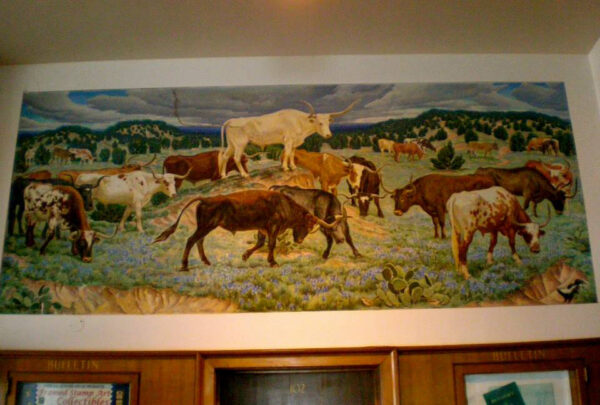
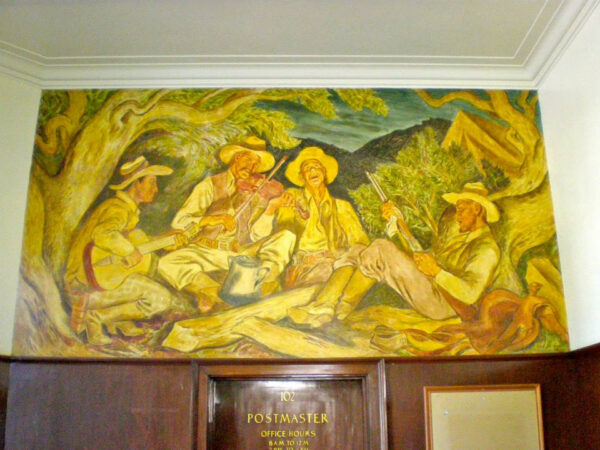
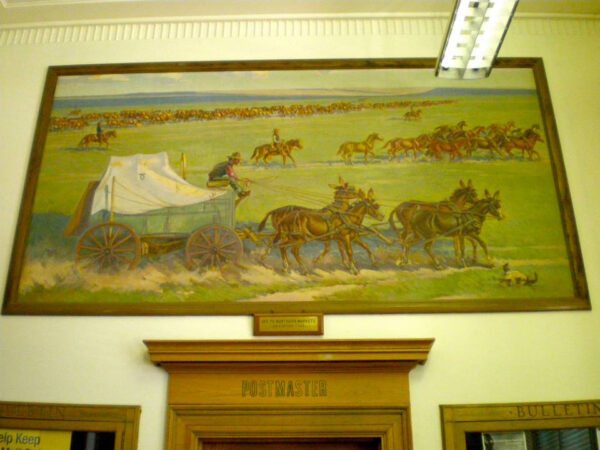
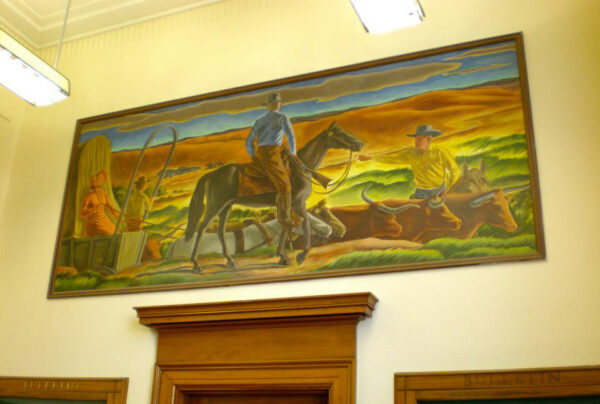
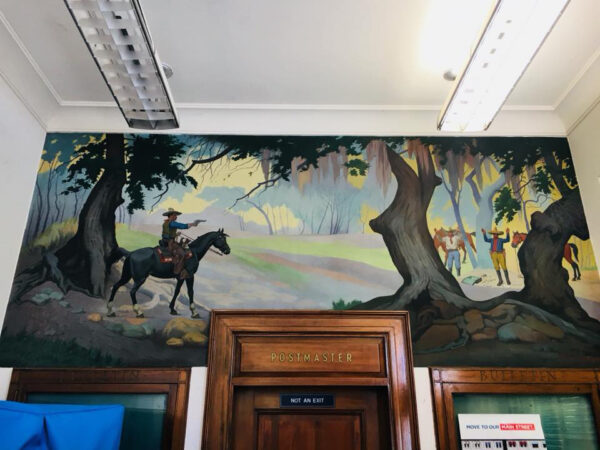

5 comments
Don’t forget the Cooper, Texas post office mural! It’s quite wonderful, and a treasure for that small town.
Thanks for such an informative article. My wife and I have seen most of those murals and I wish our photos were as good as the author’s. On a recent trip, we met the postmaster in Mart and he, unlike most postal workers we’ve encountered, was very knowledgeable about his PO mural.
What a pleasure it has been to read your articles, Leslie! You gave a thorough critical review of each mural, discussing elements of design, symbolism, history and significance of the artist. You have a positive outlook on the work, and you don’t fall prey to the glibness of much art review that I read here. Thank you!
Great series. Compelled me to order the Parisi book.
Kudos, Leslie and Glasstire, for this magnificent tour through our abundant New Deal legacy! I encourage you to log your findings and images on a website I recently learned about, The Living New Deal:
“The Living New Deal is [a crowd-sourced project that is] documenting the New Deal’s massive legacy to the country. Because New Deal public works were rarely marked, the era’s contribution to American life goes largely unseen and unappreciated. It seems inconceivable that no national register exists of what the New Deal built; yet there is none. Now the Living New Deal is rectifying that oversight – for historians but especially for the American people.”
https://livingnewdeal.org/about/